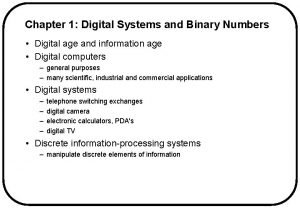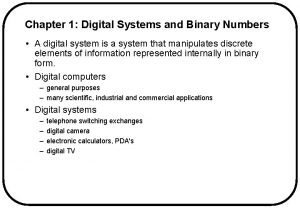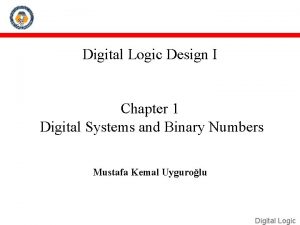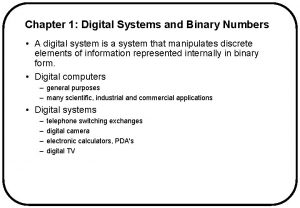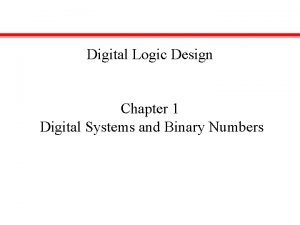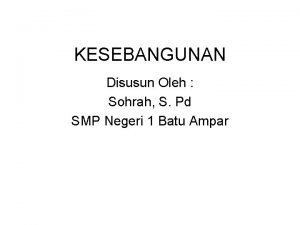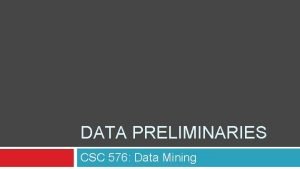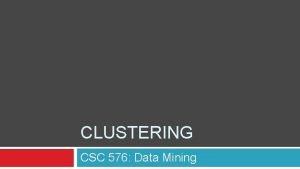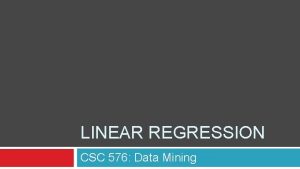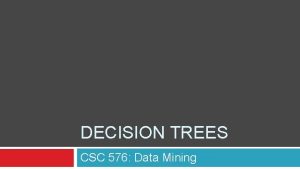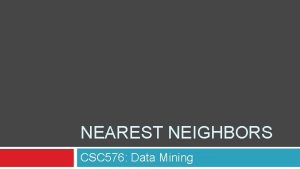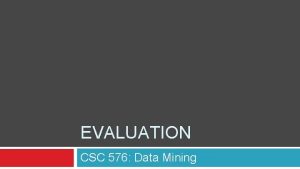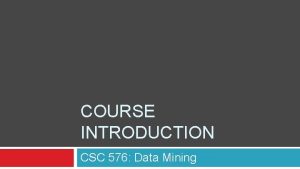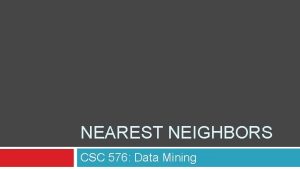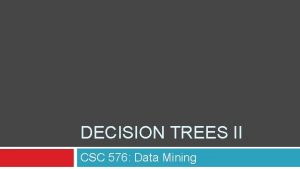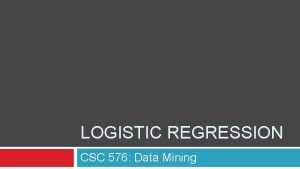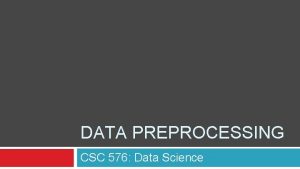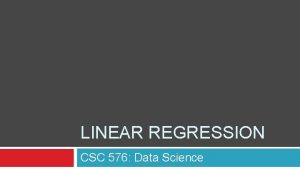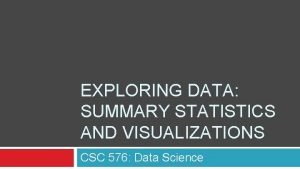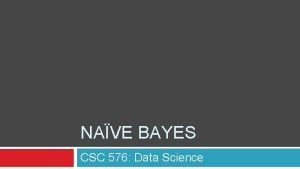DATA QUALITY DATA EXPLORATION CSC 576 Data Mining

































- Slides: 33

DATA QUALITY DATA EXPLORATION CSC 576: Data Mining

Today Data Quality Data Exploration

Data Quality Report A data quality report includes tabular reports that describe the characteristics of each feature in a dataset using standard statistical measures of central tendency and variation. � In KNA textbook, ABT refers to “Analytics Base Table” The tabular reports are accompanied by data visualizations: histogram for each continuous feature � bar plot for each categorical feature � also generally used for continuous features with cardinality < 10

Tabular Structure in a Data Quality Report Card = Cardinality Note the differences between each table. • Measures the number of distinct values present for a feature

Case Study: ABT for Motor Insurance Claims Fraud Detection




Data Exploration: Getting to Know the Data For categorical features: � � � Examine the mode, 2 nd mode, mode %, and 2 nd mode % Represent the most common levels within these features Will identify if any levels dominate the dataset. For continuous features: � � Examine the mean and standard deviation of each feature Get a sense of the central tendency and variation of the values Examine the minimum and maximum values to understand the range that is possible for each feature Histograms of continuous features will resemble the following well understood shapes (probability distributions) Recognizing the distribution of values for a feature will be useful when applying machine learning models

Uniform Distribution A uniform distribution indicates that a feature is equally likely to take a value in any of the ranges present. Sometimes indicative of a feature such as an ID, rather than something more interesting

Naturaly occurring phenomena (heights, weights of a randomly selected group of men, women) tend to follow a normal distribution. Normal Distribution Features following a normal distribution are characterized by a strong tendency towards a central value and symmetrical variation to either side of this. Unimodal: single peak around the central tendency

Skewed Distributions Skew is simply a tendency towards very high (right skew) or very low (left skew) values.

Examples: number of times a person has been married; number of times a person has made an insurance claim Exponential Distribution In a feature following an exponential distribution the likelihood of occurrence of a small number of low values is very high, but sharply diminishes as values increase.

Example: measure of heights of a randomly selected group of Irish men and women Multimodal Distribution A feature characterized by a multimodal distribution has two or more very commonly occurring ranges of values that are clearly separated. Bi-modal distribution: two clear peaks “two normal distributions pushed together” Tends to occur when a feature contains a measurement made across two distinct groups

Normal Distribution The probability density function for the normal distribution (or Gaussian distribution) is x is any value μ (mu) and σ (sigma) are parameters that define the shape of the distribution � the population mean and population standard deviation

Standard normal distribution: μ = 0 and σ = 1.

68 -95 -99. 7 Rule The 68 − 95 − 99. 7 rule is a useful characteristic of the normal distribution. The rule states that approximately: � 68% of the observations will be within one σ of μ � 95% of observations will be within two σ of μ � 99. 7% of observations will be within three σ of μ. Very low probability of observations occurring that differ from the mean by more than two standard deviations.


Case Study Become familiar with the central tendency and variation of each feature using the data quality report. Note bar graphs and histograms (earlier slides). � Note number of levels and frequency of Injury Type. What is the type of probability distribution for each histogram? Exponential Distribution: all except Income and Fraud Flag � Normal Distribution: Income (except for the 0 bar) � Fraud Flag: not a typical continuous feature �

Identifying Data Quality Issues A data quality issue is loosely defined as anything unusual about the data in an ABT. The most common data quality issues are: missing values 1. Rule of thumb: remove feature if more than 60% of data is missing irregular cardinality 2. Cardinality of 1: everything has the same value; no useful predictive information Continuous features will usually have a cardinality value close to the number of instances Investigate further if cardinality seems much lower or higher than expected outliers (invalid vs. valid) 3. Investigate using domain knowledge Compare gap between 3 rd quartile and max vs. median and 3 rd quartile

Case Study (refer to earlier tables and graphs) 1. Missing Values � � 2. Irregular Cardinality � � � 3. Remove Marital Status feature Note Income feature No predictive information in Insurance Type Fraud Flag should be categorical feature Other valid features with very low cardinality Outliers � � Unusual minimum value in instance #3 Claim Amount, Total Claimed, Num Claims, Amount Received seem to have high maximum values compared to the 3 rd quartile and median Locate instance in the dataset that leads to high maximum values (instance #460) Judge if it is a valid or invalid outlier

Identifying Data Quality Issues Data quality issues possible due to invalid data. � Need to be corrected! (e. g. calculation errors, data entry errors, …) Data quality issues possible due to valid data. � Sometimes ok, sometimes not. (Depends on the machine learning model. ) � (e. g. missing data)

Data Quality Unrealistic to expect that data will be perfect Some data mining algorithms are more susceptible to data quality issues Want to avoid “garbage in garbage out” Data cleaning phase for detection and correction of data issues often necessary during preprecessing

Measurement and Data Collection Errors Measurement error: any problem resulting from the measurement process; value recorded differs from true value to some extent Data collection error: � data objects are omitted � attribute values are missing for some objects � inappropriately including a data object

Outliers 1. Data objects that have characteristics that differ from most other data objects � 2. Value of an attribute is very unusual with respect to the typical value � In fraud detection, the goal is identifying these outliers Do we have a “data error? ” or is some individual really eight foot tall? Various statistical definitions for what an outlier is. Outliers can be legitimate data objects or values (and may be of interest).

Missing Values Often, values for some attributes are missing for some objects in data sets � Example: individuals who decline to provide their weight in a survey What to do?

Strategies for Dealing with Missing Data 1. 2. 3. Eliminate data objects that have missing values Eliminate data attributes if any objects are missing that value Estimate missing values � Data 4. set may contain similar data points Ignore missing values � If data mining method is robust

Inconsistent Values Example: � Data object with address, city, zip code in three separate fields � But address / city is in a different zip code Some inconsistencies are easy to detect (and fix) automatically; others are not.

Duplicate Data Example: � many people receive duplicate mailings because they are in a database multiple times under slightly different names

Other Issues Timeliness � Data starts to age as soon as it has been collected � Example: general population of users interact with Facebook differently than they did so 2 years ago Relevance � Sampling bias: occurs when a sample is not representative of the overall population � Example: survey data describes only those who responded to the survey

Other Issues The data sets needs to contain attributes which are relevant for the overall problem � Example: Constructing an accurate model that predicts the accident rate for drivers might be fruitless without features such as: age, etc. previous accident history, # of speeding tickets,

Knowledge about the Data Ideally data sets are accompanied by documentation that describes different aspects of the data � Read it! � Example: contains information that missing values for a particular field are coded as -9999 � Should also document the type of feature (nominal, etc. ) and its measurement scale (meters or feet, etc. )

References Fundamentals of Machine Learning for Predictive Data Analytics, Kelleher et al. , First Edition
 Eck
Eck Multimedia data mining
Multimedia data mining Mineral exploration and mining active reading
Mineral exploration and mining active reading Strip mining vs open pit mining
Strip mining vs open pit mining Strip mining before and after
Strip mining before and after Difference between strip mining and open pit mining
Difference between strip mining and open pit mining Web text mining
Web text mining Steve seitz uw
Steve seitz uw Factors of 576
Factors of 576 Bcd addition of 184 and 576
Bcd addition of 184 and 576 Rh nomenclature
Rh nomenclature Bcd addition of 184 and 576
Bcd addition of 184 and 576 Ece 576
Ece 576 Ece 576
Ece 576 Bcd addition of 184 and 576
Bcd addition of 184 and 576 Digital systems and binary numbers
Digital systems and binary numbers Bcd addition of 184 and 576
Bcd addition of 184 and 576 Syarat kesebangunan 2 benda adalah
Syarat kesebangunan 2 benda adalah Using 10's complement subtract 72532-3250
Using 10's complement subtract 72532-3250 Bcd addition of 184 and 576
Bcd addition of 184 and 576 Data reduction in data mining
Data reduction in data mining What is data mining and data warehousing
What is data mining and data warehousing What is missing data in data mining
What is missing data in data mining Concept hierarchy generation for nominal data
Concept hierarchy generation for nominal data Data reduction in data mining
Data reduction in data mining Data reduction in data mining
Data reduction in data mining Data cube technology in data mining
Data cube technology in data mining Data reduction in data mining
Data reduction in data mining Perbedaan data warehouse dan data mining
Perbedaan data warehouse dan data mining Data mining dan data warehouse
Data mining dan data warehouse Olap data mart
Olap data mart Complex data types in data mining
Complex data types in data mining Data warehousing data mining and olap
Data warehousing data mining and olap Noisy data in data mining
Noisy data in data mining










